The Alpha Persei Cluster is a bright open cluster located approximately 570 light-years away in the northern constellation Perseus. With an apparent magnitude of 1.2, the cluster is easily visible to the unaided eye. It gets its name from its brightest member, the supergiant star Mirfak (Alpha Persei), the brightest star in Perseus. The cluster is also known by the catalogue designations Melotte 20 and Collinder 39.
The Alpha Persei Cluster occupies 6.1 degrees of the sky and is one of the largest visible open star clusters in the sky. At a distance of 570 light-years, it appears around 0.30 magnitudes fainter due to extinction by interstellar dust. It is best seen in binoculars and small telescopes.
The cluster is sometimes referred to as the Alpha Persei Moving Group. Its stars were formed together in the same stellar nursery at about the same time, and they move together through space. The centre of the cluster appears northeast of Mirfak.
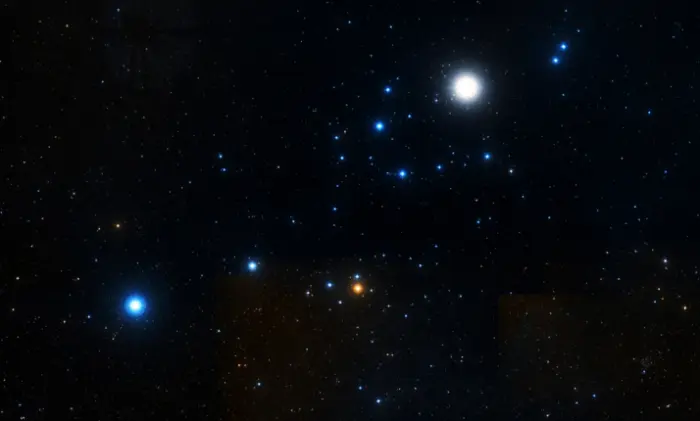
Alpha Persei Cluster (Melotte 20), image: Wikisky
The Alpha Persei Cluster is one of the few open star clusters located within 200 parsecs of the Sun and younger than 200 million years. It has an estimated age of 50 – 70 million years. Many of the cluster members are unresolved binary systems.
A 2019 study found a core radius of 11.4 ± 1.4 light-years, a half-mass radius of 18 light-years, and a tidal radius of 70.6 ± 8.5 light-years for the cluster. The study authors identified 517 members within the tidal radius.
The Alpha Persei Cluster has undergone mass segregation, the process by which the more massive cluster members move towards to cluster’s centre while the less massive stars move away from it.
A 2022 study identified three massive white dwarfs whose positions and proper motions indicate that they are escapees from the Alpha Persei Cluster. The ultramassive white dwarfs are young enough to have formed at around the same time as the cluster members.
The study authors found the white dwarfs using data in the Gaia Early Data Release 3 (Gaia EDR3). They searched for white dwarfs that may have escaped from the cluster in the past 81 million years. One of these stellar remnants, catalogued as Gaia EDR3 4395978097863572, has a mass of about 1.20 solar masses. It is believed to have evolved from a star with a mass of 8.5 solar masses, on the threshold for being a supernova candidate.
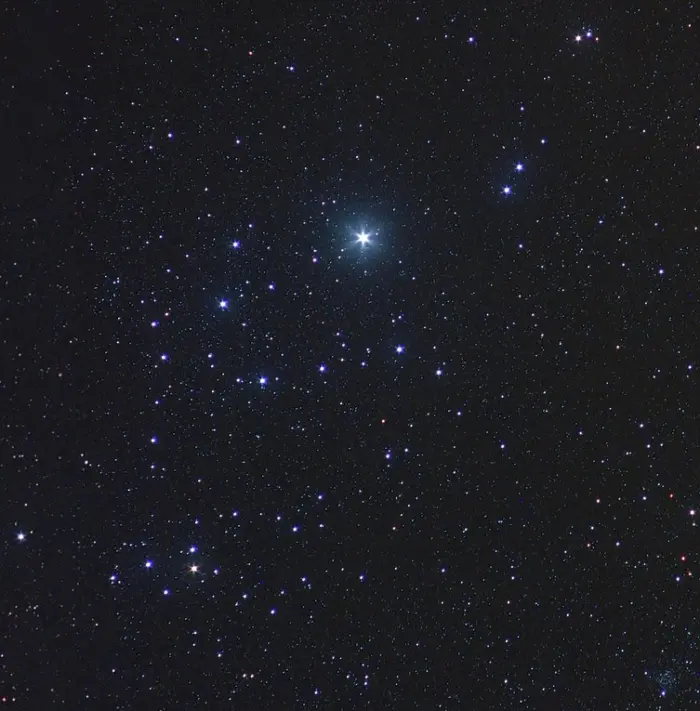
Mirfak cluster, image credit: Martin Gembec (CC BY-SA 4.0)
Stars
The brightest member of the Alpha Persei Cluster is Mirfak, a yellow-white supergiant located approximately 510 light-years away. Mirfak shines at magnitude 1.806 and is on average the 33rd brightest star in the sky. It is the lucida of the constellation Perseus, outshining the variable Algol. The name Mirfak is derived from the Arabic word for “elbow.” It comes from a longer phrase meaning “the elbow of the Pleiades” and does not refer to the star’s position in the constellation Perseus.
Mirfak has a mass 8.5 times that of the Sun and has expanded to a size of 68 solar radii. It is 5,000 times more luminous than the Sun. The supergiant is a young star, with an estimated age of 41 million years. It has evolved fast due to its high mass and is already in the last stages of its life cycle. It hosts a candidate exoplanet, but the planet’s existence has not been confirmed.
The brightest stars in Melotte 20 are mostly hot, luminous B-type stars. Delta Persei is a blue giant (B5 III) that shines at magnitude 3.01 from a distance of 520 light-years. Psi Persei is a hot blue main sequence star (B5 Ve) whose brightness varies from magnitude 4.17 to 4.28. In contrast, Sigma Persei is an orange giant (K3 III) with an apparent magnitude of 4.36.
Other visible stars in the Alpha Persei Cluster include the hot blue B-type main sequence stars 29 Persei, 30 Persei, 34 Persei, and 48 Persei.
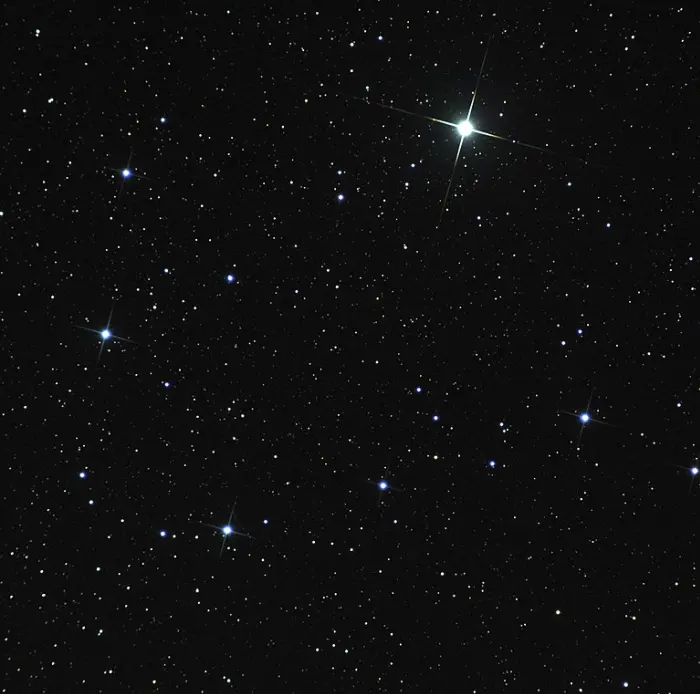
Mirfak (Alpha Persei), image credit: Wikimedia Commons/ Egres73 (CC BY-SA 3.0)
Facts
The cluster is part of the Segment of Perseus, a prominent curving pattern of stars that makes the constellation Perseus recognizable. The asterism stretches from just below Cassiopeia’s W in the direction of the constellation Auriga. While the asterism is not strictly defined, most observers consider it to be formed by Mirfak with Delta Persei, Sigma Persei, Psi Persei, Gamma Persei, and Miram (Eta Persei).
A 2020 study found tidal tails associated with the cluster. The tails are thought to be of galactic origin. The study authors also reported the presence of a stellar stream in the background of the cluster. The stars in the stellar stream are around 5 billion years old, significantly older than the cluster members. The stream lies 90 parsecs (293 light-years) behind the cluster from our point of view. It contains a significant population of white dwarfs and is believed to be the remnant of a massive old cluster.
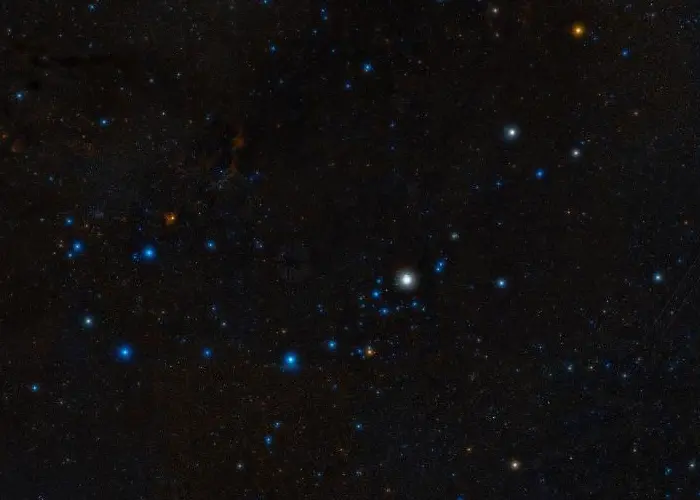
Alpha Persei Cluster and the Segment of Perseus, image: Wikisky
Location
The Alpha Persei Cluster is very easy to find and makes an excellent target for beginners. Mirfak can be found using the stars of Cassiopeia and Andromeda. A line extended from Gamma Cassiopeiae, the central star of Cassiopeia’s W, through Ruchbah, the bottom left star, points towards Mirfak. The supergiant appears to extend the chain formed by Andromeda’s three brightest stars – Alpheratz, Mirach and Almach – to the east.
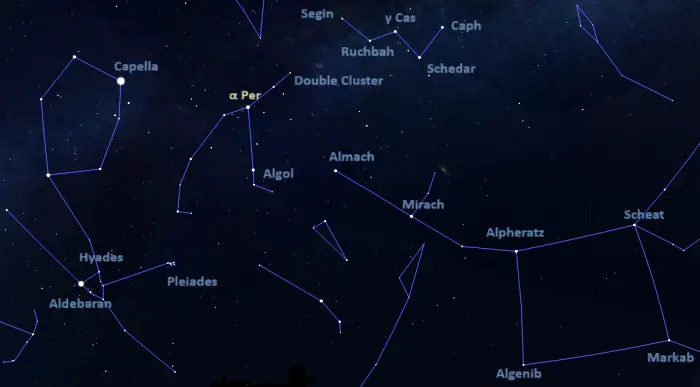
The location of the Alpha Persei Cluster, image: Stellarium
The Mirfak cluster is one of the several exceptionally bright open clusters in this region of the sky. The Pleaides and the Hyades in Taurus appear to the south and southeast. The fainter Double Cluster in Perseus appears between Mirfak and Ruchbah in Cassiopeia, and Messier 34 lies in the region between Algol in Perseus and Almach in Andromeda.
At declination +48°48’, the Alpha Persei Cluster is visible from locations north of the latitude 41° S. The best time of the year to observe the cluster and other deep sky objects in Perseus is during the month of December, when the constellation climbs high above the horizon in the evening.
Alpha Persei Cluster – Melotte 20
| Constellation | Perseus |
| Right ascension | 03h 26m 28.1s |
| Declination | +48° 58′ 30″ |
| Apparent magnitude | 1.2 |
| Apparent size | 6.1° |
| Distance | 570 light-years (175 parsecs) |
| Radius | 11.4 ± 1.4 light-years (core), 18 ly (half-mass), 70.6 ± 8.5 ly (tidal) |
| Age | 50 – 70 million years |
| Names and designations | Alpha Persei Cluster, Mirfak Cluster, Collinder 39 (Cr 39), Melotte 20 (Mel 20), OCl 392.0, Per OB3, C 0318+484, Theia 133 |